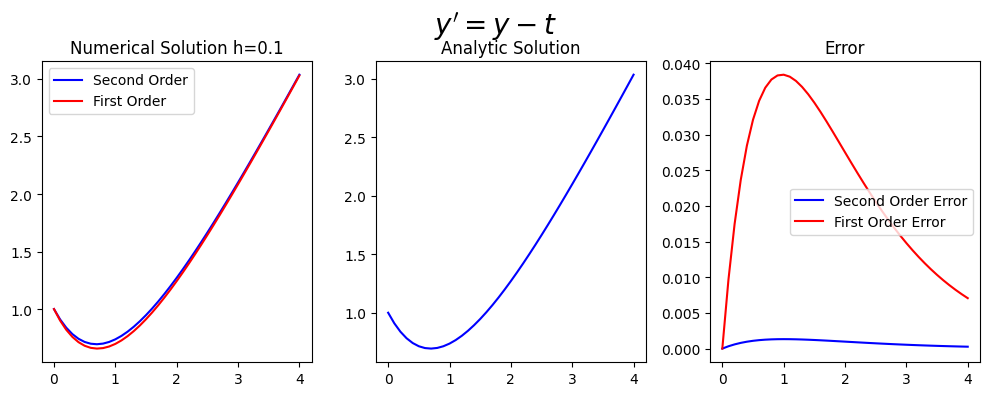1st vs 2nd order Taylor methods#
Intial Value Poblem#
The general form of the population growth differential equation
(105)#\[\begin{equation} y^{'}=t-y, \ \ (0 \leq t \leq 4), \end{equation}\]
with the initial condition
(106)#\[\begin{equation}x(0)=1, \end{equation}\]
For N=4 with the analytic (exact) solution
(107)#\[\begin{equation} y= 2e^{-t}+t+1. \end{equation}\]
Taylor Solution#
(108)#\[\begin{equation} f(t,y)=t-y, \end{equation}\]
differentiate with respect to \(t\),
(109)#\[\begin{equation} f'(t,y)=1-y'=1-t+y, \end{equation}\]
This gives the first order Taylor,
(110)#\[\begin{equation}T^1(t_i,w,i)=f(t_i,w_i)=t_i-w_i, \end{equation}\]
and the second order Taylor,
(111)#\[\begin{equation}
T^2(t_i,w,i)=f(t_i,w_i)+\frac{h}{2}f'(t_i,w_i)=t_i-w_i+\frac{h}{2}(1-t_i+w_i).\end{equation}\]
The first order Taylor difference equation, which is identical to the Euler method, is
(112)#\[\begin{equation}
w_{i+1}=w_i+h(t_i-w_i). \end{equation}\]
The second order Taylor difference equation is
(113)#\[\begin{equation}
w_{i+1}=w_i+h(t_i-w_i+\frac{h}{2}(1-t_i+w_i)). \end{equation}\]
import numpy as np
import math
%matplotlib inline
import matplotlib.pyplot as plt # side-stepping mpl backend
import matplotlib.gridspec as gridspec # subplots
import warnings
warnings.filterwarnings("ignore")
def Second_order_taylor(N,IC):
x_end=4
x_start=0
INTITIAL_CONDITION=IC
h=x_end/(N)
N=N+1;
Numerical_Solution=np.zeros(N)
Numerical_Solution_first=np.zeros(N)
t=np.zeros(N)
Analytic_Solution=np.zeros(N)
Upper_bound=np.zeros(N)
t[0]=x_start
Numerical_Solution[0]=INTITIAL_CONDITION
Numerical_Solution_first[0]=INTITIAL_CONDITION
Analytic_Solution[0]=INTITIAL_CONDITION
for i in range (1,N):
Numerical_Solution_first[i]=Numerical_Solution_first[i-1]+h*(t[i-1]-Numerical_Solution_first[i-1])
Numerical_Solution[i]=Numerical_Solution[i-1]+h*(t[i-1]-Numerical_Solution[i-1]+h/2*(1-t[i-1]+Numerical_Solution[i-1]))
t[i]=t[i-1]+h
Analytic_Solution[i]=2*math.exp(-t[i])+t[i]-1
fig = plt.figure(figsize=(10,4))
# --- left hand plot
ax = fig.add_subplot(1,3,1)
plt.plot(t,Numerical_Solution,color='blue',label='Second Order')
plt.plot(t,Numerical_Solution_first,color='red',label='First Order')
plt.legend(loc='best')
plt.title('Numerical Solution h=%s'%(h))
# --- right hand plot
ax = fig.add_subplot(1,3,2)
plt.plot(t,Analytic_Solution,color='blue')
plt.title('Analytic Solution')
#ax.legend(loc='best')
ax = fig.add_subplot(1,3,3)
plt.plot(t,np.abs(Analytic_Solution-Numerical_Solution),color='blue',label='Second Order Error')
plt.plot(t,np.abs(Analytic_Solution-Numerical_Solution_first),color='red',label='First Order Error')
plt.title('Error')
plt.legend(loc='best')
# --- title, explanatory text and save
# --- title, explanatory text and save
fig.suptitle(r"$y'=y-t$", fontsize=20)
plt.tight_layout()
plt.subplots_adjust(top=0.85)
Second_order_taylor(40,1)

